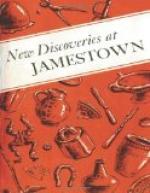Lead-glazed Earthenware.—Most of these vessels were made for utilitarian purposes, and were usually glazed only on the inside. While some were made at Jamestown, the majority were imported from England. One type, a grit-tempered earthenware, was manufactured in North Devonshire. Another kind, a hard-fired earthenware, was also made in England. At least two distinct types of local-made earthenware have been found, and, as many examples have well-proportioned shapes and attractive designs, it is evident that they were not fashioned by a young apprentice, but by a trained potter who took pride in shaping his wares.
English Sgraffito-ware (a slipware).—This colorful pottery, beautifully decorated with incised designs, is an English earthenware of red or buff clay on which a slip was applied. Before firing, a decoration was scratched, stippled, or cut through the slip, exposing the darker color of the body. The entire piece then received a transparent lead glaze, either clear or covered with an oxide. The English sgraffito-ware found at Jamestown was made near Barnstaple, in North Devonshire, probably after 1640. The reddish-brown floral and geometric designs which decorate the vessels are unusually attractive against colorful yellow backgrounds. Sgraffito is an Italian word meaning scratched.
English Slip-decorated-ware.—This colorful English pottery, which was made for everyday use, is a lead-glazed earthenware decorated with a liquid clay or slip. The design was usually dropped or trailed upon the ware from the spout (or quill) of a slip cup, somewhat in the manner a baker decorates a cake with icing; or it may have been painted over a large area or placed on in molded pads. Although most of the slip-decorated-ware found at Jamestown was made in England, there is some evidence that a few vessels may have been manufactured in America during the late 17th century.
English Redware with Marbled Slip Decoration.—On this type English earthenware, which usually has a red body, the liquid slip was marbled or combed over the surface of the vessel with a toothed instrument of wire or leather to produce the effect of paper-marbling. Some in the Jamestown collection appear to have been made as early as 1625.
Italian Maiolica.—Maiolica is a word derived from a type of pottery made on the Spanish island of Mallorca. The 17th-century Italian maiolica-ware found at Jamestown is a red-body earthenware with scratched or incised designs—a true sgraffito-ware. Somewhat similar in appearance to the English sgraffito-ware, the desired design was scratched through the cream-colored slip, revealing the reddish-brown body beneath. On many examples, colorful lines were hand painted over or near the incised designs, usually in reds, yellows, and greens, and were covered with a transparent lead glaze.
[Illustration: English redware with marbled slip decoration, 1625-50 period or earlier, unearthed at Jamestown.]




